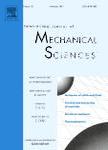版权所有:内蒙古大学图书馆 技术提供:维普资讯• 智图
内蒙古自治区呼和浩特市赛罕区大学西街235号 邮编: 010021

作者机构:Lanzhou Univ Technol Coll Energy & Power Engn Lanzhou 730050 Peoples R China Lanzhou Univ Technol Adv Technol Res Inst Jiuquan Jiuquan 735000 Peoples R China Lanzhou Univ Technol Key Lab Adv Pumps Valves & Fluid Control Syst Minist Educ Lanzhou 730050 Peoples R China
出 版 物:《INTERNATIONAL JOURNAL OF MECHANICAL SCIENCES》 (Int J Mech Sci)
年 卷 期:2025年第287卷
核心收录:
学科分类:08[工学] 0802[工学-机械工程] 0801[工学-力学(可授工学、理学学位)]
基 金:Lanzhou University of Technology, LUT National Natural Science Foundation of China, NSFC, (52179086, 52269022, 23ZYQA0320)
主 题:Underwater explosion Fluid-structure interaction Shock wave Re-entrant jet Bubble dynamic
摘 要:Traditional underwater explosion bubble dynamics research, based on the point-source detonation assumption, typically regards bubbles as regular spheres. However, in applications such as underwater directional damage and bubble detection, deformed high-pressure bubbles demonstrate greater potential. This study introduces a novel scientific interest: the dynamics of two-phase deformed bubbles. Based on a charge structure encapsulated by a two-phase fluid layer, a bidirectional fluid-structure interaction numerical scheme is employed to systematically investigate the interactions between two-phase bubbles and a moving elasto-plastic structure. The findings reveal that, due to the impedance mismatch between the TNT and air media, a portion of the shock energy is redirected into the bubble interior as reflected waves at the TNT-air interface. This process effectively enhances the bubble s volumetric potential energy and lifespan, while inducing lagging wave effects on the opposite side. The non-uniform distribution of the two-phase medium inside the bubble alters its anisotropic compressibility, causing regions with higher compressibility to collapse more rapidly and triggering the re-entrant jets. This represents a novel mechanism of re-entrant jet induction, primarily driven by the anisotropic compressibility of the two-phase medium within the bubble. This mechanism exhibits distinct physical characteristics compared to the pressure-driven jet formation observed in traditional bubble dynamics. Moreover, it is weakly to boundary conditions, demonstrating strong independence. Compared to spherical bubbles, two-phase bubbles display a greater variety of mechanisms for imposing extreme loads on structures, including re-entrant jet loading, high-energy contact loading, and impulsive loading. The loads exerted by these bubbles result in three distinct structural deformation modes. These findings provide anew perspective on the dynamics of bubble-structure interactions and o